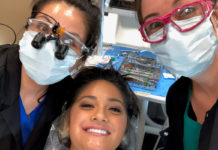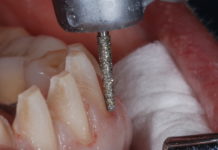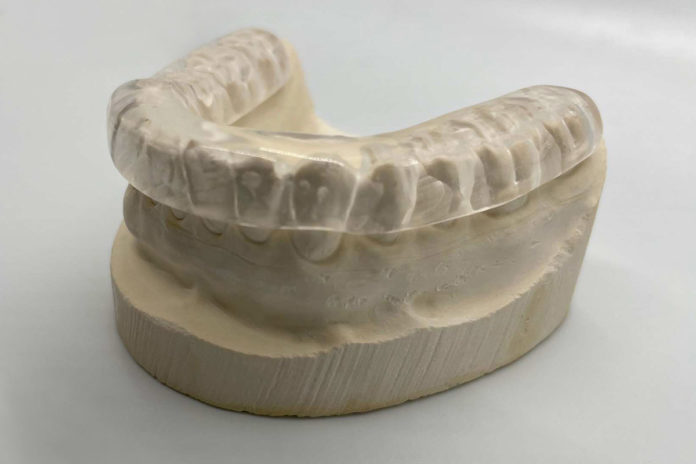
Orthotics, mouthguards, the LêDowns appliance, and splints are all considered oral appliances. At Arrowhead Dental Laboratory, we generally prefer that dentists use those terms with patients instead of the more generic term “nightguards,” because “nightguards“ often refer to inexpensive mass-market products.
Aesthetic Dentistry offers several tips for dental practices when prescribing and treating patients. The following are suggestions for getting appliances that fit perfectly the first time, taking good impressions, caring for oral appliances, and limiting the number of remakes.
Orthotics that don’t fit will break. When a “new” orthotic comes back to the dental lab because it is broken, we always try to understand what happened to cause the break. There can be many reasons for a broken orthotic. Arrowhead’s first step is to look at the original impression. If the original impression didn’t capture all of the teeth or has pulls in it, then the orthotic won’t fit the mouth perfectly and it will require a new impression.
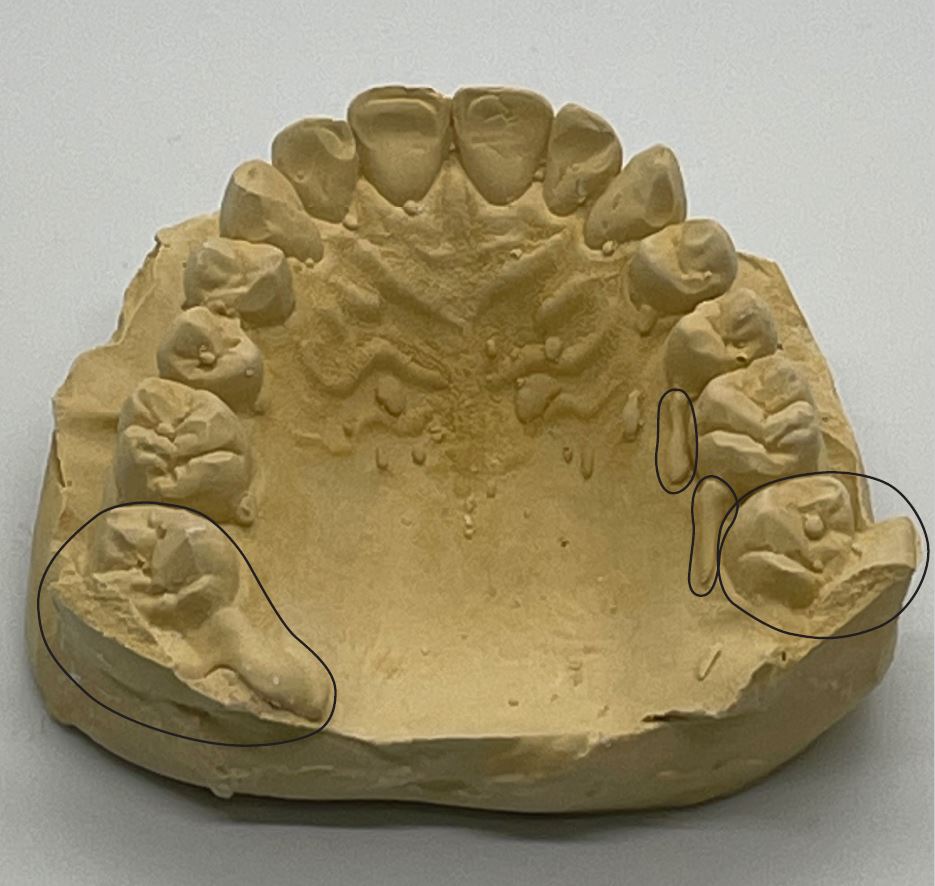
Take a Good Impression
To get an appliance that fits, doctors (or their team member) must insist on getting a good impression. A dental lab can only deliver a product based on that impression. Therefore, if a doctor or team member doesn’t get a good impression on the first try, it’s best to take the impression again.
Here’s our recommendations for good impressions:
- Use a material such as alginate. Alginate tends to be much more accurate than an alginate substitute. With alginate, even though dentists or their team members have to take an added step of pouring their own models, the results are much better.
- Pay careful attention to the back of the mouth. Most impressions with “issues” are compromised on the molars because it can be tricky to get an impression tray in the back of the mouth.
- Insist on quality work. As the dentist, don’t accept a mediocre impression from your assistants. Work with them until they understand what is required, and practice taking impressions until they do it correctly. At Arrowhead, we’ve teamed up with Ivoclar Vivadent to offer impression training and it can be a big help. Contact Arrowhead Dental Lab for more information about training.
- Scan the patient’s mouth/teeth. Use a digital scanner to get quality images for the lab to use and make models from. Digital scans eliminate some variables of conventional impressions.
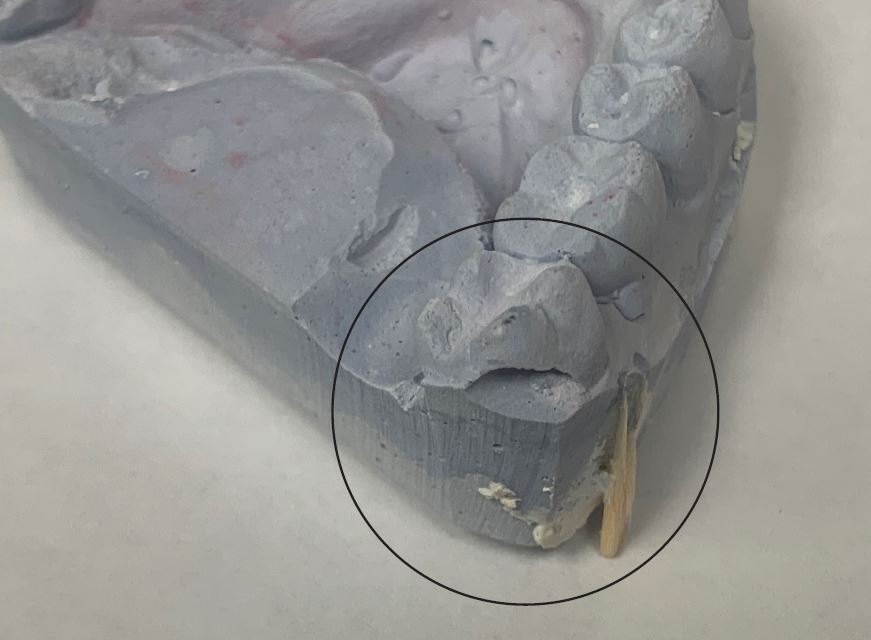
As a dentist, insist on quality work—don’t accept a mediocre impression from your assistants. Work with them until they understand what is required, and practice taking impressions until they do it correctly.
Making Minor Adjustments
Sometimes, minor problems with an oral appliance’s fit can be adjusted in the dental office. Keep in mind, however, that not all appliances are the same and each must be adjusted differently. A “hard” orthotic is made from polymethyl methacrylate (PMMA). A hard/soft orthotic is PMMA on the outside and Astron (a thermal composite) on the inside.
Here are some general tips on the most common issues, and what to do:
- It’s too tight.
- Heat it up. If the orthotic is made of Astron or similar material, try placing it in hot water for a few minutes, and then try to seat it again. When the orthotic cools down to a normal temperature, it will settle in and take the patient’s form. If a doctor puts a cold orthotic [made of thermal composite] in a patient’s mouth, it doesn’t have as much flex as a warm one. Keep in mind that this method doesn’t work on PMMA appliances because they don’t flex at all—whether hot or cold.
- Make an adjustment. If after heating it up, the orthotic still needs adjusting, take a small acrylic bur (not a diamond bur) and knock out some of the interproximals.
- Take a new impression. If none of these suggestions yield the results you want, take a new impression for a remake.
- It’s too loose.
- Take a new impression. In this case, the orthotic will likely have to be remade. In occasional circumstances, such as for young patients whose teeth have no natural undercuts, we might be able to add clasps to an oral appliance. But in most cases, a remake is unavoidable.
- It’s too thin.
- Don’t adjust any orthotic below 2 mm. According to the manufacturers, dental orthotics need to be 2 millimeters thick to keep them from breaking. If a doctor makes adjustments down to 1.5 millimeters of thickness, the chances of the orthotic breaking are greatly increased.
- It’s too open in the anterior.
- The less overbite a patient has, the more open it looks in the anterior. Check the orthotic’s thickness between the molars—again, the orthotic should be 2 millimeters thick.
- It’s “new” and it’s cracking.
- There’s probably a space between the appliance and the patient’s anatomy. If there’s any gap, the orthotic will crack and eventually break. This gap is caused by a less-than-perfect impression, so the best solution is a new one and a remake.
- It’s wearing out too fast.
- Consider using a hard (PMMA) orthotic instead of a hard/soft one. Patients who grind their teeth will continue to grind on an oral appliance. For them, a hard appliance is going to be a better choice.

Many oral appliances are used because of problems from an underlying dental issue, such as bruxism, TMD, or sleep. In such circumstances, the orthotic may break because the issue isn’t being addressed with a long-term solution like full mouth rehabilitation or sleep dentistry.
Doctors should remind their patients that oral appliances may protect against bruxism or help with TMD in the short term, but they should never be substituted for long-term treatment and care.
Many oral appliances are used because of problems from an underlying dental issue, such as bruxism, TMD, or sleep. In such circumstances, the orthotic may break because the issue isn’t being addressed with a long-term solution like full mouth rehabilitation or sleep dentistry.
Maintenance for the Appliance
In order to get the maximum lifespan out of an oral appliance, it should be cared for properly. Remember that oral appliances are designed to be worn in the mouth—a wet environment. Therefore, they should be kept in water or a solution (i.e., soaking) when not being used in the mouth.
If oral appliances are left out in a dry environment, they will start to get cracks because the air will dry them out. In general, oral appliances aren’t meant to last forever, but if they are properly cared for and fit well, they should last for a year or two.
Set Realistic Expectations
It’s important for patients to understand that some oral appliances are made to protect a patient’s investment in dentistry while others are intended to establish a patient’s new vertical. The appliances are not meant to last indefinitely—they are meant to wear out over time so that their dentistry doesn’t.
If a well-fitting appliance is broken over time, it could be a positive thing. Without the appliance, there could have been damage to a patient’s dentition or restorations. It’s always better for an oral appliance to break rather than the dentistry. Therefore, set the proper expectation with patients that eventually all oral appliances will wear out, break, and need to be replaced.
Another helpful tip is to dial-in your orthotics by checking the timing and force of how a patient occludes on the orthotic with a T-Scan™. For most patients, Arrowhead recommends using a lower orthotic for better function.
The Bottom Line
- Take a good impression and make sure you capture the full molars.
- Troubleshoot tight-fitting orthotics by heating them up before seating, or by making minor adjustments to the interproximals with an acrylic bur.
- Do not adjust any orthotic to less than 2mm thickness.
- When the appliance is delivered, read the instructions on the bag that the appliance comes in, and follow the directions for proper care.
- Don’t use oral appliances as a long-term replacement for comprehensive dental treatments.


